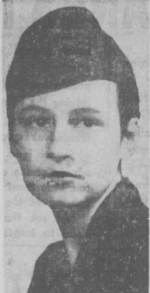Safe and Legal in New York, 1971
"Tammy" traveled from Ohio to New York to undergo an abortion under New York's liberal abortion law. Her abortion was performed on September 25, 1971. She was 33 years old. After the abortion, Tammy developed an infection which finally ended her life on October 13, 1971.
A Lay Abortionist in Boston, 1939
 |
| Barbara Hanson |
On October 13, 1939, the body of Barbara Hanson, age 21, was found in a Boston motel room. Barbara had checked into the motel herself under an assumed name the previous day. At about 2:00 a.m., other guests at the motel complained to management about loud noises, described in some accounts as screams, coming from the room.
A hotel employee detective went to the room and found Barbara dead on the bed. She was tentatively identified by the I.D. found in her purse. The identification was verified by her uncle.
Police found fingerprints on four empty cocktail glasses and an open bottle on the bedside table.
Four men were in the room with her: I. Bernard Gannon, age 23, James Carter, 27, Raymond Fermino, 26, and George F. Norton, 26. Reports say that one of them admitted on the spot to having perpetrated an abortion on Barbara, but the reports to not specify which one.
An autopsy showed that immediately after the abortion, Barbara had suffered a fatal heart attack. Barbara's father, Frederick S. Hanson, a Penn State building engineer, went to New York to claim her body. When questioned by reporters, he said, "I just received worth that Barbara had passed on. I don't know any of the circumstances."
Nineteen-year-old "Cathy," identified in the source as "Miss R," used a catheter on herself to abort a six-week pregnancy. She went to a doctor for aftercare, and the physician packed her uterus with gauze.
Two days later, on September 25, 1908, she was admitted to Cook County Hospital. Her condition wasn't alarming. Her pulse of 90, respirations of 24, and temperature of 99.6 indicated a mild infection. Her uterus was enlarged and tender. Upon examination, a doctor was able to put two fingers through Cathy's dilated cervix, and noted "blood clots" in the uterus.
The next day, Cathy's condition was very much the same, if not slightly improved with a pulse of 80, respirations of 28, and temperature of 99.4. She was subjected to a uterine curettage, followed by irrigation and packing.
All the surgery did was make things worse. The localized infection had, through the scraping of the uterus, become a generalized case of toxemia. Cathy's condition deteriorated over the course of 17 days until her death on October 13.
A Philadelphia Physician, 1838
A Philadelphia boarding house owner named Mary Kingsley reported that on October 4, 1838, a Dr. Henry Chauncey appeared at breakfast time. "He made me make some tea of a powder that looked like black pepper." The tea was given to 21-year-old Elizabeth "Eliza" Sowers, who until the previous May had been a worker at a paper mill in Manayunk, NJ. She'd been brought to the boarding house -- one of unsavory reputation -- by Chauncey the day before.
At around 2:00 the following morning, Eliza called to the boarding house owner. "She said she was very bad. She said, 'I won't take any more of that doctor's medicine; it will kill me.'"
Chauncey returned later, performing some sort of procedure upon Eliza with something "which shined and looked like a knitting needle," according to the owner of the boarding house. Chauncey said that Eliza was "the most difficult person he had ever operated on. Said the medicine he gave her was too powerful, and had acted too quick."
Eliza died on October 13 from the ministrations of Dr. Chauncey. Chauncey and Nixon arrived at Eliza's family home that evening to say that she had died of "impacted bowels." A second doctor, William Armstrong, had signed a death certificate to that effect.
Eliza's brother was having none of it. He demanded that Eliza's body be exhumed and examined, revealing the real cause of her death.
The three men went to trial using a defense based on attacking the reputations of Eliza, her family, her fiancé, and the woman who ran the boarding house. Armstrong and Nixon won acquittals, and Chancey was convicted only of malpractice, not the double murder of Eliza and her unborn baby.
No comments:
Post a Comment